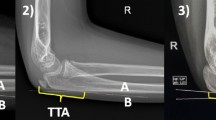Abstract
Purpose
To define the optimum design of the anatomical preshaped olecranon plate.
Methods
The geometry of the proximal ulna was studied in 200 paired Caucasian ulnae, using a digital caliper and goniometer. Gender and side differences were analyzed. Results were compared with the corresponding geometrical parameters of three olecranon plates with different contour. All three plates were placed on the dorsal surface of a “model” ulna, i.e., a right dried ulna having osteometric parameters similar to the averages of our sample, and plate-to-bone fit was examined in two planes.
Results
The proximal ulna had an 8.48° (2.1°–15.7°) mean varus angulation and an 8.49° (1.70°–14.10°) mean anterior angulation, located on average 8.19 cm (5.68–11.66 cm) and 8.63 cm (5.28–11.92 cm) distal to the bone’s most proximal point, respectively. The mean olecranon angle was 110.34° (98.70°–125.80°) and the olecranon length was 1.58 cm on average (1.20–2.12 cm). Only the plate having both varus and anterior angulation presented a good plate-to-bone fit in both planes.
Conclusions
A “true” anatomical preshaped olecranon plate should have both varus and anterior angulation close to the average angulations of the normal ulna and located in a certain distance from its proximal edge. The olecranon part of the plate should primarily not exceed the olecranon length and secondarily be close to the average olecranon angle. We believe that such a plate may facilitate intraoperative restoration of the proximal ulna complex anatomy, when dealing with comminuted or Monteggia fractures, thus leading to better postoperative results.




Similar content being viewed by others
References
Anderson ML, Larson N, Merten SM, Steinmann SP (2007) Congruent elbow plate fixation of olecranon fractures. J Orthop Trauma 21:386–393
Brownhill JR, Mozzon JB, Ferreira LM, Johnson JA, King GJW (2009) Morphologic analysis of the proximal ulna with special interest in elbow implant sizing and alignment. J Shoulder Elbow Surg 18:27–32
Buijze G, Kloen P (2009) Clinical evaluation of locking compression plate fixation for comminuted olecranon fractures. J Bone Joint Surg Am 91:2416–2420
Cottias P, Camara KB, Clavert P, Kahn J, Livernaux PA (2010) Digastric olecranon osteotomy: feasibility study of a new approach to the elbow. Surg Radiol Anat 32:485–489
Dakoure PWH, Ndiaye A, Sane AD, Niane MM, Seye SIL, Dia A (2007) Posterior surgical approaches to the elbow: a simple method of comparison of the articular exposure. Surg Radiol Anat 29:671–674
Erturer RE, Sever C, Sonmez MM, Ozcelik IB, Akman S, Ozturk I (2011) Results of open reduction and plate osteosynthesis in comminuted fracture of the olecranon. J Shoulder Elbow Surg 20:449–454
Goldberg SH, Omid R, Nassr AN, Beck R, Cohen MS (2007) Osseous anatomy of the distal humerus and proximal ulna: implications for total elbow arthroplasty. J Shoulder Elbow Surg 16:S39–S46
Grechening W, Clement H, Pichler W, Tesch NP, Windisch G (2007) The influence of lateral and anterior angulation of the proximal ulna on the treatment of a Monteggia fracture: an anatomical cadaver study. J Bone Joint Surg Br 89-B:836–838
Kozin SH, Berglung LJ, Cooney WP, Morrey BF, An K-N (1996) Biomechanical analysis of tension band fixation for olecranon fracture treatment. J Shoulder Elbow Surg 5:442–448
Marsh M, Patel N, Limb D (2010) Ann R Coll Surg Engl 92:532–533
Kieffer EM, Bouchaid J, Bierry G, Clavert P (2013) CT arthrography and anatomical correlation of the bare area of the ulnar trochlear fossa: a risk of misdiagnosis of cartilage ulcerations. Surg Radiol Anat. doi:10.1007/s00276-013-1200-7
Puchwein P, Schildhauer TA, Schöffmann S, Heidari N, Windisch G, Pichler W (2012) Three-dimensional morphometry of the proximal ulna: a comparison to currently used anatomically preshaped ulna plates. J Shoulder Elbow Surg 21:1018–1023
Quintero J, Varecka T (2007) Olecranon, radial head, and complex elbow injuries. In: Ruedi TP, Buckley R, Moran C (ed) AO principles of fracture management, vol 2, 2nd edn. Thieme Medical Publishers, New York, pp 628–633
Rouleau DM, Faber KJ, Athwal GS (2010) The proximal ulna dorsal angulation: a radiographic study. J Shoulder Elbow Surg 19:26–30
Rouleau DM, Canet F, Chapleau J, Petit Y, Sandman E, Faber KJ et al (2012) The influence of proximal ulnar morphology on elbow range of motion. J Shoulder Elbow Surg 21:384–388
Wang AA, Mara M, Hutchinson DT (2003) The proximal ulna: an anatomic study with relevance to olecranon osteotomy and fracture fixation. J Shoulder Elbow Surg 12:293–296
Windisch G, Clement H, Grechenig W, Tesch NP, Pichler W (2007) A morphometrical study of the medullary cavity of the ulna referred to intramedullary nailing. Surg Radiol Anat 29:47–53
Windisch G, Clement H, Grechenig W, Tesch NP, Pichler W (2007) The anatomy of the proximal ulna. J Shoulder Elbow Surg 16:661–666
Conflict of interest
The authors declare that they have no conflict of interest.
Author information
Authors and Affiliations
Corresponding author
Rights and permissions
About this article
Cite this article
Totlis, T., Anastasopoulos, N., Apostolidis, S. et al. Proximal ulna morphometry: which are the “true” anatomical preshaped olecranon plates?. Surg Radiol Anat 36, 1015–1022 (2014). https://doi.org/10.1007/s00276-014-1287-5
Received:
Accepted:
Published:
Issue Date:
DOI: https://doi.org/10.1007/s00276-014-1287-5




